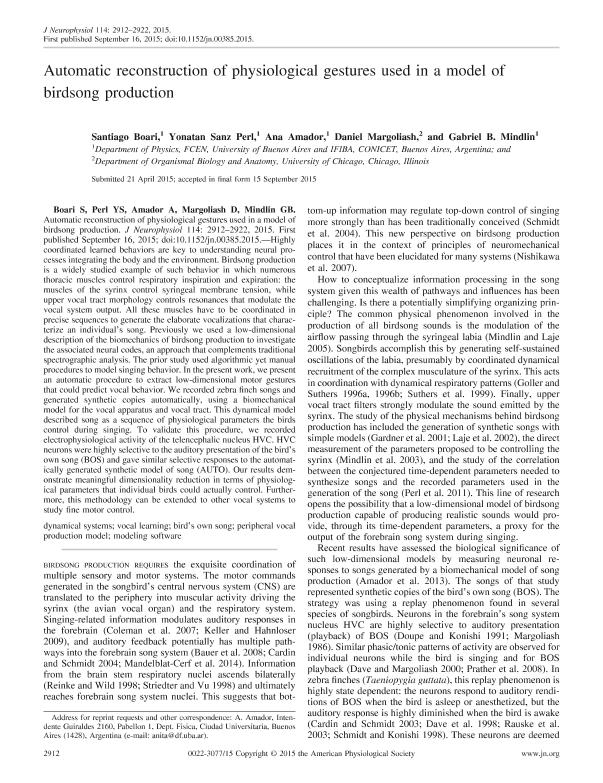Mostrar el registro sencillo del ítem
dc.contributor.author
Boari, Santiago

dc.contributor.author
Yonatan Sanz Perl
dc.contributor.author
Amador, Ana

dc.contributor.author
Margoliash, Daniel
dc.contributor.author
Mindlin, Bernardo Gabriel

dc.date.available
2018-06-08T17:27:11Z
dc.date.issued
2015-09
dc.identifier.citation
Boari, Santiago; Yonatan Sanz Perl; Amador, Ana; Margoliash, Daniel; Mindlin, Bernardo Gabriel; Automatic reconstruction of physiological gestures used in a model of birdsong production; American Physiological Society; Journal of Neurophysiology; 114; 5; 9-2015; 2912-2922
dc.identifier.issn
0022-3077
dc.identifier.uri
http://hdl.handle.net/11336/47891
dc.description.abstract
Highly coordinated learned behaviors are key to understanding neural processes integrating the body and the environment. Birdsong production is a widely studied example of such behavior in which numerous thoracic muscles control respiratory inspiration and expiration: the muscles of the syrinx control syringeal membrane tension, while upper vocal tract morphology controls resonances that modulate the vocal system output. All these muscles have to be coordinated in precise sequences to generate the elaborate vocalizations that characterize an individual´s song. Previously we used a low-dimensional description of the biomechanics of birdsong production to investigate the associated neural codes, an approach that complements traditional spectrographic analysis. The prior study used algorithmic yet manual procedures to model singing behavior. In the present work, we present an automatic procedure to extract low-dimensional motor gestures that could predict vocal behavior. We recorded zebra finch songs and generated synthetic copies automatically, using a biomechanical model for the vocal apparatus and vocal tract. This dynamical model described song as a sequence of physiological parameters the birds control during singing. To validate this procedure, we recorded electrophysiological activity of the telencephalic nucleus HVC. HVC neurons were highly selective to the auditory presentation of the bird´s own song (BOS) and gave similar selective responses to the automatically generated synthetic model of song (AUTO). Our results demonstrate meaningful dimensionality reduction in terms of physiological parameters that individual birds could actually control. Furthermore, this methodology can be extended to other vocal systems to study fine motor control.
dc.format
application/pdf
dc.language.iso
eng
dc.publisher
American Physiological Society

dc.rights
info:eu-repo/semantics/openAccess
dc.rights.uri
https://creativecommons.org/licenses/by-nc-sa/2.5/ar/
dc.subject
Dynamical Systems
dc.subject
Vocal Learning
dc.subject
Bird'S Own Song
dc.subject
Modeling Software
dc.subject.classification
Astronomía

dc.subject.classification
Ciencias Físicas

dc.subject.classification
CIENCIAS NATURALES Y EXACTAS

dc.subject.classification
Astronomía

dc.subject.classification
Ciencias Físicas

dc.subject.classification
CIENCIAS NATURALES Y EXACTAS

dc.title
Automatic reconstruction of physiological gestures used in a model of birdsong production
dc.type
info:eu-repo/semantics/article
dc.type
info:ar-repo/semantics/artículo
dc.type
info:eu-repo/semantics/publishedVersion
dc.date.updated
2018-05-04T21:32:38Z
dc.journal.volume
114
dc.journal.number
5
dc.journal.pagination
2912-2922
dc.journal.pais
Estados Unidos

dc.journal.ciudad
Bethesda
dc.description.fil
Fil: Boari, Santiago. Universidad de Buenos Aires. Facultad de Ciencias Exactas y Naturales. Departamento de Física. Laboratorio de Sistemas Dinámicos; Argentina. Universidad de Buenos Aires. Facultad de Ciencias Exactas y Naturales. Departamento de Física. Laboratorio de Sistemas Dinámicos; Argentina
dc.description.fil
Fil: Yonatan Sanz Perl. Universidad de Buenos Aires. Facultad de Ciencias Exactas y Naturales. Departamento de Física. Laboratorio de Sistemas Dinámicos; Argentina. Universidad de Buenos Aires. Facultad de Ciencias Exactas y Naturales. Departamento de Física. Laboratorio de Sistemas Dinámicos; Argentina
dc.description.fil
Fil: Amador, Ana. Universidad de Buenos Aires. Facultad de Ciencias Exactas y Naturales. Departamento de Física. Laboratorio de Sistemas Dinámicos; Argentina. Universidad de Buenos Aires. Facultad de Ciencias Exactas y Naturales. Departamento de Física. Laboratorio de Sistemas Dinámicos; Argentina
dc.description.fil
Fil: Margoliash, Daniel. University of Chicago; Estados Unidos
dc.description.fil
Fil: Mindlin, Bernardo Gabriel. Universidad de Buenos Aires. Facultad de Ciencias Exactas y Naturales. Departamento de Física. Laboratorio de Sistemas Dinámicos; Argentina. Universidad de Buenos Aires. Facultad de Ciencias Exactas y Naturales. Departamento de Física. Laboratorio de Sistemas Dinámicos; Argentina
dc.journal.title
Journal of Neurophysiology

dc.relation.alternativeid
info:eu-repo/semantics/altIdentifier/url/http://jn.physiology.org/content/114/5/2912
dc.relation.alternativeid
info:eu-repo/semantics/altIdentifier/doi/http://dx.doi.org/10.1152/jn.00385.2015
Archivos asociados
